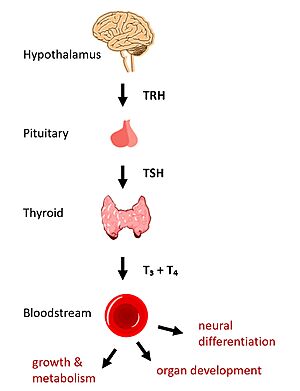Sandbox Reserved 1774
From Proteopedia
(Difference between revisions)
| Line 20: | Line 20: | ||
Central to the biological function of TSHR is its hinge motion which allows for transition between active and inactive states. Deformation of the hinge region accommodates up-and-down rotation of the extracellular domain as a rigid body about an imaginary 55 degree axis. When the extracellular domain is upright, the receptor actively signals for thyroid hormone production. When the extracellular domain is hinged down, the receptor is inactive and no signaling activation occurs. Notably, transition between the two states occurs spontaneously; favoring of the active or inactive conformation is influenced by hinge interactions and ligand binding <ref name="Faust">PMID:35940205</ref>. | Central to the biological function of TSHR is its hinge motion which allows for transition between active and inactive states. Deformation of the hinge region accommodates up-and-down rotation of the extracellular domain as a rigid body about an imaginary 55 degree axis. When the extracellular domain is upright, the receptor actively signals for thyroid hormone production. When the extracellular domain is hinged down, the receptor is inactive and no signaling activation occurs. Notably, transition between the two states occurs spontaneously; favoring of the active or inactive conformation is influenced by hinge interactions and ligand binding <ref name="Faust">PMID:35940205</ref>. | ||
| - | At the following link is an animation of TSHR transition between the two states: [[Image:TSHR_MorphBetterAngle.mp4|Figure 1]]. The following trends can be observed in the video or viewed through an overlay in the molecule viewer: | + | At the following link is an animation of TSHR transition between the two states: [[Image:TSHR_MorphBetterAngle.mp4|Figure 1]]. The following trends can be observed in the video or viewed through an <scene name='95/952702/Overlay/1'>overlay</scene> in the molecule viewer: |
#Slinky-like deformation of the hinge region shifts the <scene name='95/952702/P10_movement/1'>N-terminus of the p10</scene> region 5 Angstroms over the course of the movement <ref name="Faust" />. | #Slinky-like deformation of the hinge region shifts the <scene name='95/952702/P10_movement/1'>N-terminus of the p10</scene> region 5 Angstroms over the course of the movement <ref name="Faust" />. | ||
#Stretching of the hinge pulls on the linked helices in the transmembrane domain, shifting <scene name='95/952702/Helix7_movement/1'>helix 7</scene> about 4 Angstroms inward <ref name="Faust" />. | #Stretching of the hinge pulls on the linked helices in the transmembrane domain, shifting <scene name='95/952702/Helix7_movement/1'>helix 7</scene> about 4 Angstroms inward <ref name="Faust" />. | ||
Revision as of 22:07, 2 April 2023
| This Sandbox is Reserved from February 27 through August 31, 2023 for use in the course CH462 Biochemistry II taught by R. Jeremy Johnson at the Butler University, Indianapolis, USA. This reservation includes Sandbox Reserved 1765 through Sandbox Reserved 1795. |
To get started:
More help: Help:Editing |
| |||||||||||

